| Home Eclipse Home Solar Eclipse 1999 2001 2002 2005 2008 2012 | Site Map |
In August 1999, about 200 Danes and some Norwegians travelled to Lake Balaton in Hungary, all hoping to witness the total solar eclipse on August 11th. The trip was arranged by Astronomisk Selskab (Astronomical Society) in Denmark.
I woke 6:30 by the sound of rain. And indeed, one big grey cloud ceiling and rain! Woke again 7:15, the rain had stopped and blue patches of sky could be seen to the west. During the morning it became harder to keep pessimism. It became a fine sunny day, however with thin fleecy clouds.
A group of 19 had chosen to watch the eclipse from a church hill on the outskirts of Alsóörs. From the hill we had a magnificent view over wine fields, the town, and the Lake Balaton. We arrived about an hour before first contact. As time went on, many local people also came to the hill.
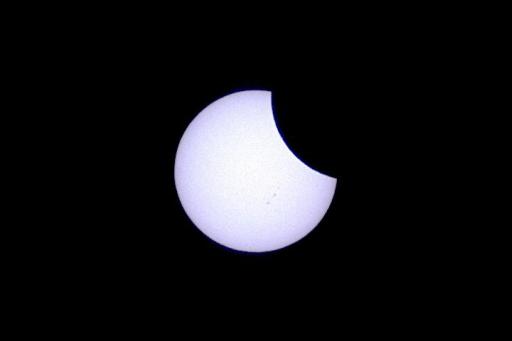 11:47 - 1 hour, 2 minutes to totality. The Sun is 25% covered.
A pair of sunspots are visible below and slightly to the right of
the center of the Sun's disk.
11:47 - 1 hour, 2 minutes to totality. The Sun is 25% covered.
A pair of sunspots are visible below and slightly to the right of
the center of the Sun's disk.
25 year old Canon FTb with FD 400mm f/4.5 lens and
FD 1.4xA converter (= 560mm f/6.3).
Exposure: f/11, 1/1000 sec, 200 ASA, Baader solar filter.
The eye was not able to recognize the darkening during the partial phase, only that the light changed and the colours of the landscape became more pale. But during the last part of the partial phase, the automatic street lights turned on and automatic cameras turned on the flash. About 5-10 minutes before totality we heard a radio nearby playing Europe's "The Final Countdown".
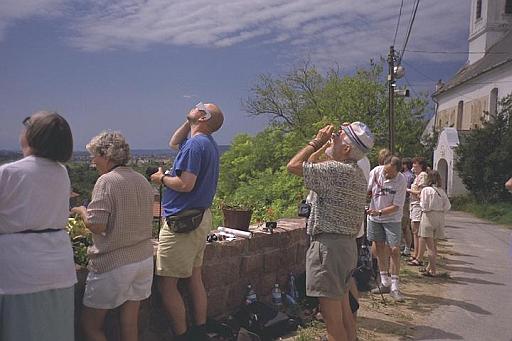 On the church hill at Alsóörs a few minutes before totality.
Note the sharp-edged shadows.
On the church hill at Alsóörs a few minutes before totality.
Note the sharp-edged shadows.
Photo: Birgit Linander. Automatic camera with the flash manually switched off.
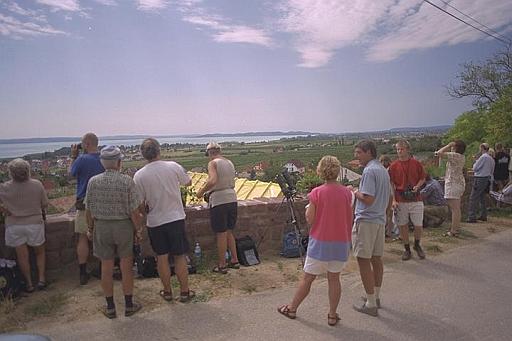 The church hill at Alsóörs 12:47 - about two minutes before
totality. According to the exposure meter of the camera, the light had
darkened to about 1% (7 f/stops) of normal daylight.
The church hill at Alsóörs 12:47 - about two minutes before
totality. According to the exposure meter of the camera, the light had
darkened to about 1% (7 f/stops) of normal daylight.
Then the show begins with shadow bands running across the ground. I had expected them to be more contrasty than they actually were, and they were not moving as fast as I had expected, just about 3-4 m/sec. Maybe they became more contrasty and were moving faster just before totality, but I didn't notice. Things started to happen very quickly and it's almost impossible to see it all.
In the west you can see the moon shadow, it looks like a storm approaching, the sickle-shaped Sun rapidly gets smaller. Suddenly - in a matter of a second or two - it's dusk, something between a night at full moon and a Danish midsummer night. The diamond ring hangs over your head. And then the corona opens like a flower.
It's breath-taking. It's so unreal. No description, no photo, can match the real experience. I knew what should happen, but when it all happened I was totally overwhelmed.
We saw the scenery through drifting fleecy clouds. But that didn't destroy the experience. Through a cloud, we could only see the inner corona but in return the prominences became more distinct. They shone with a beautiful deep red colour. Particularly one in "one-o'clock-position" was very bright. Between the clouds, we saw a large bright white corona.
While the thin clouds didn't destroy the visual experience, they did disturb my attempts to photograph the prominences and the corona. I had planned to take a short sequence of 6 photos and I had rehearsed the sequence at home. But partly because of the clouds, partly because I was overwhelmed by the experience, I only took 3. An attempt to photograph the prominences failed, the other two photos of the corona are shown below.
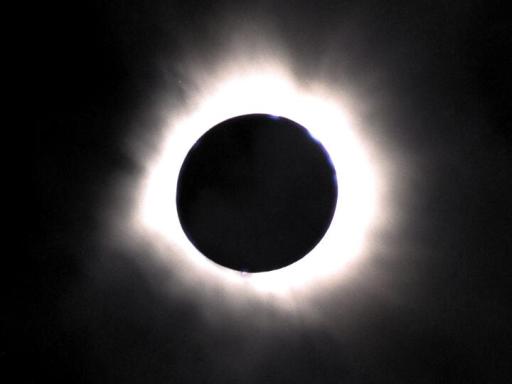 The corona seen through drifting fleecy clouds. The "notches"
on the lunar limb are overexposed prominences.
The corona seen through drifting fleecy clouds. The "notches"
on the lunar limb are overexposed prominences.
Exposure: f/6.3, 1/15 sec, no filter.
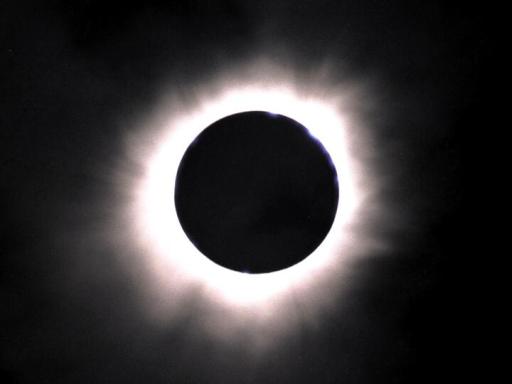 Exposure: 1/4 sec, but I think that the clouds - more than the
camera shutter - determined what should come on the film.
Exposure: 1/4 sec, but I think that the clouds - more than the
camera shutter - determined what should come on the film.
Suddenly - before you expect - the diamond ring hangs over your head again. Impossible! Where's the 2 minutes and 20 seconds? But light returned as quickly as it disappeared. Our sense of time failed completely during the totality. I felt it like only 40 seconds.
I did see Venus but I forgot to look for Mercury and stars. The binoculars were ready, but I forgot to use them during the much too short time.
But still - what an experience! The experience of the decade - no doubt about that.
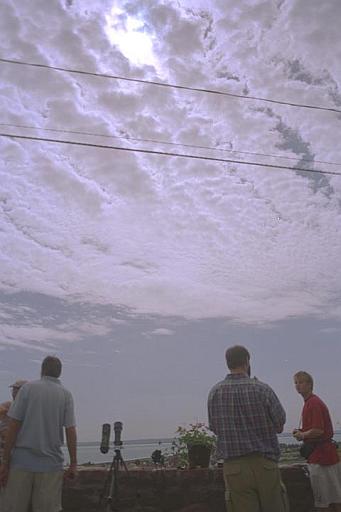 Less than one minute after totality. All those clouds!
Less than one minute after totality. All those clouds!
The gear seen in the lower part of the photo: a Kowa TS-611 birding scope and the 400mm lens, "piggy-backed".
About 15 minutes after totality we left the church hill. We didn't care to see the rest. A partial eclipse is nothing compared with a total one. It turned out that our experiences of the eclipse were very different. However we agreed on two things: it was an overwhelming experience, and it was over much too quickly.
I believe that birds are inactive during the totality. They are probably caught by surprise by the sudden darkness just as human beings are. But just two minutes before totality (second contact) I saw a bird passing by, apparently unaffected by the pale light - from the flight and the silhouette I think it was a finch, my guess: a Goldfinch (Carduelis carduelis) or a Serin (Serinus serinus). And a few minutes after totality (third contact) a Barn Swallow (Hirundo rustica) flew across - singing.
During the years I've heard many stories claiming that birds go to rest during a partial eclipse. As I saw birds flying just before totality and just after, I don't believe those stories anymore.
Reports by other Danes:
Text and photos: Stig Linander, created: 1999-08-17, last revised: 2008-08-19